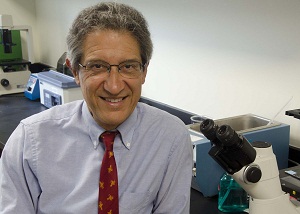Section - Banner - Research

Breadcrumb
- Research
- Researcher Profiles
- Face to Face
- Dr. Salvatore Carbonetto
Navigation Menu
- Research Centres
- Programs
- Researcher Profiles
|
FACE TO FACE with Dr. Salvatore Carbonetto, a scientist with a far-reaching vision who studies the microscopically small - Professor, Departments of Neurology, Medicine and Biology at McGill University - Member of the Research Institute of the McGill University Health Centre (RI-MUHC) |
 |
|
Aug. 25, 2015 Below is an interview with a scientist who studies the microscopically small while maintaining a far-reaching vision. You discovered two important cell adhesion molecules (CAMs). What are CAMs? Salvatore Carbonetto : Cell adhesion molecules, as the name indicates, help cells stick to each other and to their surroundings. When I started out in research in the early 80s, it was known that cells could recognize one another during development. For instance, liver cells unite as liver cells, brain cells aggregate as brains cells, etc. In the nervous system, this recognition among cells is particularly complicated. For instance, in the developing brain, axons – which serve as the wires connecting parts of the brain – grow out, find and adhere to their specific targets. CAMs are located on the cell surface and enable that recognition. My lab discovered two types of CAMs that are essential for brain development: integrins and dystroglycans. You are currently investigating how dystroglycan is related to muscular dystrophies, intellectual disability and autism. Why is that relationship important? S.C.: CAMs play an important role in synapses, which are "cellular switches" in the brain essential for information processing, memory storage and virtually all other brain functions. CAMs allow synapses to connect into circuits. That's why patients with muscular dystrophies caused by mutations that affect the gene for dystroglycan will also have severe intellectual deficits. Now that we have basic information of how dystroglycan affects the function of synapses in the brain of patients, we are trying to apply those insights to restore proper synaptic and brain function. Your discovery of dystroglycan has led to important research by other scientists into the link between CAMs and various disorders, including cancer. What's the role of dystroglycan in cancer? S.C.: Cancer cells replicate in an uncontrolled manner but they also lose their connection to other cells, move throughout the body and metastasize. Mutations that disrupt cell adhesion molecules contribute to loss of connection, tumour development and progression. Dystroglycan is a brake on tumour formation and mutations in this gene are associated with some forms of cancer such as breast, prostate and colon cancer. At a molecular level, the interactions of dystroglycan are the same in all tissues so our research on intellectual deficiencies will be important for research on cancer and muscular dystrophy. You were the Director of the Centre for Research in Neuroscience (CRN) for 10 years. How do you see the its future? S.C.: The CRN has had a long-standing interest in neural regeneration and hypothalamic function and, more recently, in neuropsychiatric disorders. We are pursuing two emerging themes: firstly, the in-depth study of autism and intellectual deficiency, in collaboration with the Montreal Neurological Institute and the Douglas Institute, and secondly, the effects of brain trauma on the visual system, as part of the RI-MUHC's new Brain Repair and Integrative neuroscience Program (BRaIN), in collaboration with the McGill Vision Research Centre. This is a new effort to propagate the collaborative and fertile intellectual environment of the CRN, which includes, other top-notch researchers with a broad vision of how the brain functions and who are experts in cutting-edge techniques. In your lab, you have trained and counselled many students. What are the guiding principles you wish to instil in them? S.C.: The first and most important thing is to train them to think critically and rigorously and then, as they develop, to encourage them to think more expansively. That's a hard balancing act, because to do careful experiments, you have to be cautious and consider anything possible that can go wrong. But with time, that can become inhibiting, so I encourage them to venture away from their comfort zone and to think out of the box. I'm proud that many of my students are now faculty members in universities in Canada and all over the world and that others are now successful businesspeople in the biotech field. You were a faculty member at The State University of New York, but decided to come to Montreal and stay here. Why? S.C.: I feel very lucky to have met Albert Aguayo, the founding director of the CRN. He and I connected, and he offered me a job here in the early 80s. I've had a rewarding career and wonderful colleagues at McGill and at the RI-MUHC. My colleagues in the CRN all have international reputations. The last three faculty members to join the group, for example, trained at Stanford, Harvard and the University College London. Mutual respect and the excellent environment of the RI-MUHC are keys to our success as a world-class team. |